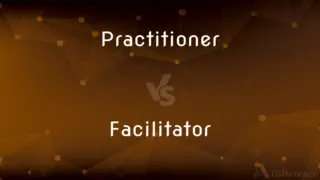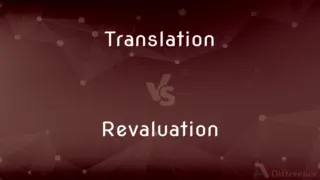Marcato vs. Staccato — What's the Difference?
Edited by Tayyaba Rehman — By Maham Liaqat — Updated on April 7, 2024
Marcato emphasizes a note with a marked and forceful manner, while Staccato indicates short, detached notes.

Difference Between Marcato and Staccato
Table of Contents
ADVERTISEMENT
Key Differences
Marcato, often symbolized by a vertical wedge above or below the note, instructs musicians to play each note with a pronounced attack, giving it a more emphasized and forceful character. This articulation suggests that each note should stand out distinctly, often with increased volume or intensity. On the other hand, Staccato, represented by a dot above or below the note, requires notes to be played in a short, detached manner, significantly reducing the sustain of each note. This creates a light, airy effect where the silence between notes is as important as the notes themselves.
While marcato aims to highlight certain notes or phrases within a piece, making them more prominent, staccato focuses on creating a texture or rhythm that is crisp and precise. The contrast between the two articulations lies in their approach to note length and emphasis: marcato stresses strength and weight, whereas staccato emphasizes brevity and separation.
In terms of performance technique, marcato requires a deliberate forceful action from the musician, whether it's a bowing technique on string instruments, a specific breath technique for wind instruments, or a particular touch on the keyboard. Staccato, however, demands a quick release after the note is played, which can involve a lighter touch or a rapid movement away from the key or string.
The musical genres or pieces that commonly employ marcato articulations include marches and dramatic, expressive parts of classical compositions, where a bold statement or effect is desired. Conversely, staccato is widely used in light, fast-paced pieces like scherzos, certain baroque music, and playful modern compositions to add a sparkling or buoyant quality.
Both marcato and staccato serve as essential tools for musicians to shape the character and texture of a piece. By manipulating note duration and emphasis, composers and performers can convey a wide range of emotions and styles, from the assertive and commanding tones of marcato to the sprightly and spirited passages created with staccato.
ADVERTISEMENT
Comparison Chart
Symbol
Vertical wedge above/below note
Dot above/below note
Interpretation
Emphasized, forceful notes
Short, detached notes
Effect on Performance
Increases volume/intensity
Reduces sustain, emphasizes silence
Technical Approach
Deliberate forceful action
Quick release, light touch
Common Usage
Marches, dramatic parts of compositions
Light, fast-paced pieces, scherzos
Compare with Definitions
Marcato
A marking that indicates a note should be played forcefully.
The marcato passages in the march brought the melody to the forefront.
Staccato
Common in fast-paced and light compositions.
The composer used staccato to inject energy into the fast sections.
Marcato
Often used to make phrases stand out.
The pianist applied marcato to accentuate each chord in the progression.
Staccato
Creates airy textures with silence between notes.
The flutist's staccato brought a crisp clarity to the melody.
Marcato
Requires increased volume or intensity.
The brass section played the marcato notes with striking power.
Staccato
Focuses on brevity and separation of notes.
The pianist's staccato passages created a sparkling effect.
Marcato
Emphasizes strength and weight in musical expression.
The violinist used marcato to highlight the main theme.
Staccato
A style of playing notes in a short, detached manner.
The staccato notes in the piece gave it a light, playful character.
Marcato
Aims to create a bold and dramatic effect.
The marcato articulation made the finale of the piece particularly impactful.
Staccato
Demands a quick release and light touch.
The guitarist's staccato technique added a rhythmic bounce to the song.
Marcato
Marcato (short form: Marc.; Italian for marked) is a musical instruction indicating a note, chord, or passage is to be played louder or more forcefully than the surrounding music. The instruction may involve the word marcato itself written above or below the staff or it may take the form of the symbol ∧, an open vertical wedge.
Staccato
Staccato ([stakˈkaːto]; Italian for "detached") is a form of musical articulation. In modern notation, it signifies a note of shortened duration, separated from the note that may follow by silence.
Marcato
With strong accentuation. Used chiefly as a direction.
Staccato
(Music) Cut short crisply; detached
Staccato octaves.
Marcato
(music) stressed; pronounced.
Staccato
Marked by or composed of abrupt, disconnected parts or sounds
Staccato applause.
Marcato
In a marked emphatic manner; - used adverbially as a direction.
Staccato
A staccato manner or sound.
Staccato
(music) An articulation marking directing that a note or passage of notes are to be played in an abruptly disconnected manner, with each note sounding for a very short duration, and a short break lasting until the sounding of the next note; as opposed to legato. Staccato is indicated by a dot directly above or below the notehead.
Staccato
(music) A passage having this mark.
Staccato
(figurative) Any sound resembling a musical staccato.
Staccato
(music) played in this style
Now, play the same passage very staccato.
Staccato
(music) Describing a passage having this mark.
Staccato
Made up of abruptly disconnected parts or sounds.
Staccato
Disconnected; separated; distinct; - a direction to perform the notes of a passage in a short, distinct, and pointed manner. It is opposed to legato, and often indicated by heavy accents written over or under the notes, or by dots when the performance is to be less distinct and emphatic.
Staccato
Expressed in a brief, pointed manner.
Staccato and peremptory [literary criticism].
Staccato
Marked by or composed of disconnected parts or sounds; cut short crisply;
Staccato applause
A staccato command
Staccato notes
Staccato
Separating the notes; in music;
Play this staccato, please
Common Curiosities
What does marcato mean in music?
Marcato indicates that notes should be played with a pronounced attack and emphasis, often louder and more forcefully.
How do you play staccato notes?
Staccato notes are played in a short, detached manner, with a quick release after the note is struck.
Do marcato and staccato change the tempo of a piece?
No, they primarily affect how individual notes are played, not the overall tempo, though they can influence the piece's energy and flow.
Is marcato louder than staccato?
Typically, yes. Marcato implies a stronger emphasis which often translates to playing louder, while staccato focuses on note length and separation.
How do marcato and staccato contribute to musical texture?
Marcato adds depth and emphasis, enhancing the music's drama and intensity, whereas staccato introduces space and rhythm, lightening the texture.
What challenges do musicians face when playing marcato?
Musicians need to balance force and control to ensure the notes are emphatic without compromising tone quality.
How do marcato and staccato affect musical interpretation?
They offer ways to vary texture and emotion in music: marcato adds weight and drama, while staccato introduces lightness and rhythm.
Are there genres where marcato and staccato are more prevalent?
Yes, marcato is common in marches and dramatic music, while staccato is often found in fast, light, and rhythmic pieces.
Can marcato and staccato be used together?
Yes, composers sometimes combine articulations to achieve specific effects, although each articulation has a distinct purpose.
Why are marcato and staccato important in music?
They help in expressing different musical ideas and emotions, adding variety and contrast to compositions.
Can all instruments perform marcato and staccato?
Yes, most instruments can interpret these articulations, though the technique varies depending on the instrument.
How do performers know when to use marcato or staccato?
Performers follow the composer's indications in the music score, which include articulation marks like marcato and staccato symbols.
What skills are important for executing staccato effectively?
Precision in timing and control over the instrument are crucial for creating the characteristic crispness of staccato.
Can the same note be played both marcato and staccato?
While unusual, composers may indicate this for a very specific and stylized effect, combining emphasis with brevity.
Can marcato and staccato be subjective in interpretation?
Yes, the extent of emphasis or detachment can vary depending on the performer's interpretation and the context of the music.
Share Your Discovery

Previous Comparison
Practitioner vs. Facilitator
Next Comparison
Translation vs. RevaluationAuthor Spotlight
Written by
Maham LiaqatEdited by
Tayyaba RehmanTayyaba Rehman is a distinguished writer, currently serving as a primary contributor to askdifference.com. As a researcher in semantics and etymology, Tayyaba's passion for the complexity of languages and their distinctions has found a perfect home on the platform. Tayyaba delves into the intricacies of language, distinguishing between commonly confused words and phrases, thereby providing clarity for readers worldwide.













































